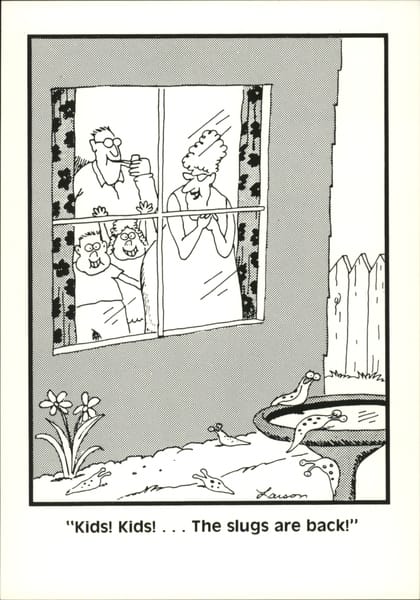In a classic Gary Larson cartoon, a family gathers excitedly by the window to see the first slugs of spring returning. But that was the 80s. Nowadays, we have very different breed of slimy invertebrate that slithers out of its den at the first sign of warmer weather. A pest that no-one is ever happy to see.

I’m talking, of course, about climate activists.
These are very seasonal pests: every summer, there they are, squawking that it’s never been so hot and we’re all gonna die. Once the weather turns a bit chilly, though, they’re mercifully nowhere to be seen.
After all, even the dimwits of climate activism are (usually) astute enough to at least grasp that waving their arms and screeching about “global warming” in a snowstorm is hardly about to persuade anyone. Which is the main reason they shifted their goalposts to “climate change”.
Still, even climate activists are prone to play at being groundhogs when it gets a bit nippy.
In February last year, headlines around the world read: “Climate crisis: Antarctic continent posts record temperature reading of 18.3 degrees Celsius”.
The World Economic Forum declared that “these record temperature rises are clear indicators of a warming planet and increase the risks relating to climate change”.
The United Nations and its World Meteorological Organisation concluded that “hundreds of millions of people are at risk from melting ice in the planet’s polar regions, linked to sea-level rise”.
This year, the Antarctic’s gone and set a new record. But the media and the climate troughers are being awfully quiet about it.
Contradicting predictions of perpetual global warming, rising sea levels and “climate catastrophe”, the South Pole has recorded its coldest winter since 1957, with the average temperature at the Amundsen–Scott South Pole Station between April and September, a bone chilling minus -78 degrees Celsius.
As a result, sea ice levels surrounding the continent rose to their fifth-highest level on record in August, according to the National Snow and Ice Data Centre.
Only last Thursday, temperatures at Russia’s Vostok Station sunk to minus -79.4 degrees Celsius, just 0.6 degrees Celsius from the world’s lowest temperature on record during October.
Even today, the temperature at the South Pole Station is -63 degrees Celsius, an incredibly low reading for early October given the southern hemisphere has just left the austral winter that normally sees average monthly temperatures of around -60 degrees Celsius.
Of course, one penguin does not an Ice Age make. Squawking that this is some kind of death knell for global warming is as foolish as the nutbars losing their minds when — surprise! — it gets really hot in summer.
What this does indicate, though, is that the climate of Antarctica, and indeed the globe, has always been changing, due to natural variability. And, so far as Antarctica is concerned: it ain’t getting hot down there.
In a paper titled “The Medieval Climate Anomaly in Antarctica” (2019), Luening, Galka and Vahrenholt concluded “temperatures, precipitation and weather extremes across the globe are characterised by systematic variability that is, to a large extent, driven by multidecadal and shorter-term ocean cycles […]
Another 18 scientists from the University of Venice, Australian Antarctic Division, University of Tasmania, Australian National University, University of Washington, Cambridge and Saint Petersburg State University also found similar natural variabilities in the Antarctic climate that stretch back to well before human industrialisation […]
The paper concluded that “based on the extended database, corroborate previously published findings for Antarctica from the PAGES 2k Consortium (2013): temperatures over the Antarctic continent show an overall cooling trend during the period from 0 to 1900 CE, which appears strongest in West Antarctica, and no continent-scale warming of Antarctic temperature is evident in the last century.”
Advance Australia
That it’s bloody cold down in Antarctica this year isn’t exactly news to us here in Tasmania.
Parts of Tasmania have been dusted with springtime snow, with a weather system dumping more rain on the already drenched state.
Snow reached as low as 400 metres on Tuesday morning and falls settled on areas including Hobart’skunanyi/Mt WellingtonMt Wellington, south of the capital and the Central Highlands.
The acting director of the State Emergency Service, Leon Smith, said there were reports of a brief snow flurry in Hobart.
It was quite nice for a few days during the week.
Another cold front is expected towards the end of the weekend.
The Guardian
No kidding. It already rained a few minutes ago. Looks like we’ve had our day of summer, then.










